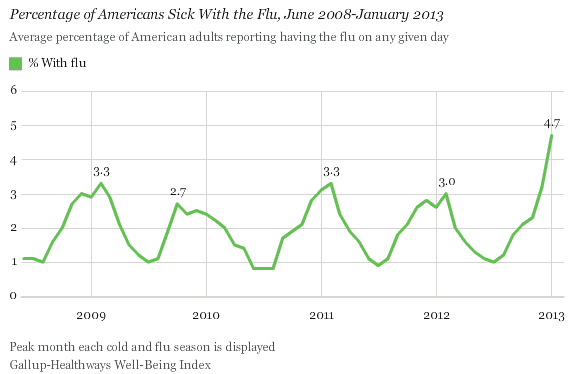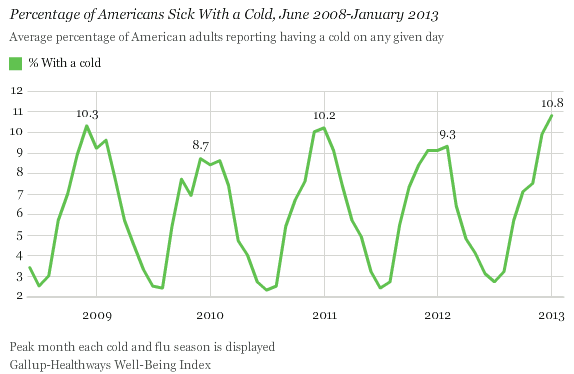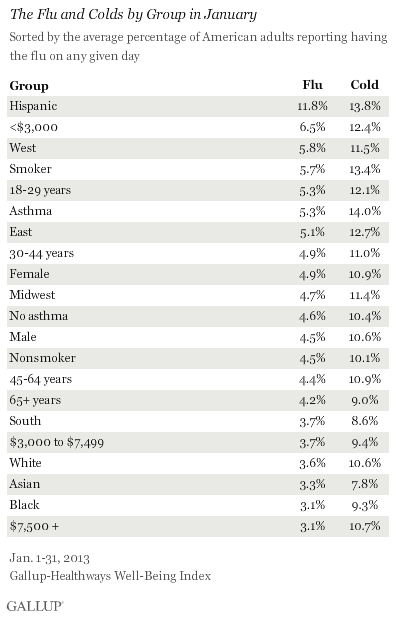WASHINGTON, D.C. -- Americans' self-reports of the flu spiked in January, increasing to the highest level Gallup has measured in any month since it started tracking flu daily in 2008. An average of 4.7% of Americans reported having the flu the day before they were surveyed in January -- up from 3.2% in December.

Americans were more likely to report having the flu on any given day in January than they were during the peak months of any of the last four flu seasons. The previous highs each flu season included an average 3.3% saying they had the flu "yesterday" in February of the 2008-2009 and the 2010-2011 seasons, 3.0% in February of the 2011-2012 season, and 2.7% in October of the 2009-2010 season amid the outbreak of the H1N1 flu virus.
Americans' self-reports of daily flu in December and January also exceeded the same months in every past year since 2008, suggesting that the 2012-2013 flu season may be the worst in five years.
The Centers for Disease Control and Prevention, which tracks clinically confirmed influenza through collaborating laboratories in all 50 states and the District of Columbia, has reported a similar trend. The CDC announced that the percentage of people visiting their healthcare provider for flu-like illnesses ranged from 4.8% during the week ending Jan. 5 to 4.4% in the week ending Jan. 26.
The Gallup-Healthways Well-Being Index asks 500 Americans each day whether they had a cold or the flu "yesterday." It is possible that the average of daily cold and flu prevalence is underestimated because those who were sick the day before may be less likely to respond to a phone survey than those who were not sick. Still, year-over-year comparisons with data from previous cold and flu seasons provide useful insights into their respective changes over time.
The percentage of Americans reporting they had a cold in January also reached a five-year high. On average, 10.8% of Americans reported having a cold on the day prior to being interviewed, up from 9.9% in December. The percentage of daily cold reports in January is still on par with peak months in past years.

Flu Rates Highest for Hispanics, Cold Rates Highest for Asthmatics
Among key subgroups, Hispanics, as is typically the case, were the most likely to report having the flu in January (11.8%). Hispanics are also among the groups most likely to report having a cold in January, 13.8%, which is similar to the rate for respondents who have ever been diagnosed with asthma (14.0%). Lower-income Americans were more likely than middle- or higher-income Americans to report having the flu (6.5%) or a cold (12.4%). Smokers were also among the subgroups most likely to report having the flu (5.7%) or a cold (13.4%).

Bottom Line
Americans' average daily reports of the flu and colds in January were the highest Gallup has found since 2008. These illnesses likely decrease workplace productivity, increase absenteeism, and increase medical costs for both employers and employees. Thus, this severe flu season could negatively impact an already struggling economy. Public health officials and employers should be mindful of the widespread nature of the flu and colds and the potential negative impact on individuals, workplaces, and the U.S. economy.
About the Gallup-Healthways Well-Being Index
The Gallup-Healthways Well-Being Index tracks well-being in the U.S. and provides best-in-class solutions for a healthier world. To learn more, please visit well-beingindex.com.
Survey Methods
Results are based on telephone interviews conducted as part of the Gallup-Healthways Well-Being Index survey Jan. 1-31, 2013, with a random sample of more than 14,759 adults, aged 18 and older, living in all 50 U.S. states and the District of Columbia.
For results based on the total sample of national adults, one can say with 95% confidence that the margin of sampling error is ±1 percentage point.
Interviews are conducted with respondents on landline telephones and cellular phones, with interviews conducted in Spanish for respondents who are primarily Spanish-speaking. Each sample of national adults includes a minimum quota of 50% cell phone respondents and 50% landline respondents, with additional minimum quotas by region. Landline telephone numbers are chosen at random among listed telephone numbers. Cell phones numbers are selected using random digit dial methods. Landline respondents are chosen at random within each household on the basis of which member had the most recent birthday.
Samples are weighted to correct for unequal selection probability, nonresponse, and double coverage of landline and cell users in the two sampling frames. They are also weighted to match the national demographics of gender, age, race, Hispanic ethnicity, education, region, population density, and phone status (cellphone only/landline only/both, cellphone mostly, and having an unlisted landline number). Demographic weighting targets are based on the March 2012 Current Population Survey figures for the aged 18 and older U.S. population. Phone status targets are based on the July-December 2011 National Health Interview Survey. Population density targets are based on the 2010 census. All reported margins of sampling error include the computed design effects for weighting.
In addition to sampling error, question wording and practical difficulties in conducting surveys can introduce error or bias into the findings of public opinion polls.
For more details on Gallup's polling methodology, visit https://www.gallup.com/.
